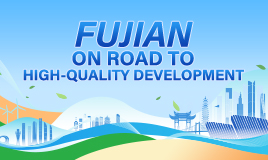Revolutionary bases' growth to get a boost
Focal points include stabilizing poverty alleviation, improving infrastructure
As China set in motion an agenda to narrow social inequalities and regional growth gaps, the nation's top policymakers have given priority to a special type of regions-areas where the Communist Party of China built up its revolutionary cause before founding the New China.
While China has already secured a decisive victory in its fight against absolute poverty, the central government has unveiled a host of policy documents this and last year to support the growth of old revolutionary bases, most of which were in underdeveloped areas with poor natural conditions.
Key measures include ensuring the stability of poverty alleviation policies, promoting the coordinated development of small and large cities, bettering the infrastructure network and improving the quality of public services.
The development of the old revolutionary base areas was also highlighted in China's 14th Five Year Plan (2021-25), which pledged to promote the vitalization of such regions with steps to develop industries with local characteristics and promote their green and innovative growth.
Behind the policy drive is a long-term emphasis from China's top leader, President Xi Jinping, who spent seven years of his youth in a village in Yan'an, Shaanxi province, which is one of the birthplaces of the Chinese revolution.
Xi, who is also general secretary of the CPC Central Committee, called Yan'an his second home, and the village, Liangjiahe, the place where he was taught to live and work, and where he made up his mind to serve the people.
Zhang Keyun, a regional economics professor at Renmin University of China, said Xi has developed a strong understanding of and emotional attachment to the people living in the less-developed areas of his youth, which is an important factor contributing to his long-term emphasis in his governance experience.
He said it is also a common policy practice globally to bridge the growth gap between different areas and that the nation has set an example in this regard.
China made the people from the old revolutionary base areas a focus in the national poverty alleviation campaign, a centerpiece of Xi's agenda from 2013 to 2020.
Over the past decade, the president has outlined strategies and set as a requirement improving the well-being of local residents as he made trips to a majority of China's old revolutionary bases.
In 2015, during a symposium with officials in Yan'an, Xi stressed that China must always treasure and remember the major sacrifices and contributions made by the people in such bases.
He highlighted the developing of the old revolutionary bases and the improvements in the living standards of poor people from such areas as an integral part of China's drive to build a moderately prosperous society in all respects, saying that authorities must beef up support to accelerate the development of the regions and enable the people to live better lives.
To beef up the support to the nation's old revolutionary bases, the State Council, China's Cabinet, rolled out a series of policy documents supporting the growth of different regions-including the southern part of Jiangxi province, parts of Shaanxi and Gansu provinces, and the Ningxia Hui autonomous region-in improving their infrastructure and public services, and amplifying their regional strengths to improve people's living standards.
Li Zhimeng, dean of the institute of development strategies at the Jiangxi Academy of Social Sciences, said Xi's vision has slowly panned out with the steady improvement in the living standards of people in less-developed regions, and many impoverished regions managed to develop industries that expanded residents' sources of income.
A key part of China's poverty alleviation campaign, she said, is to put in place long-term mechanisms and support policies.
In Jiangxi, where some of the earliest centers of the Party's activity were located, the government's aid packages have enabled a stark improvement in the housing conditions of rural residents and stronger social security networks for underprivileged groups.
Li noted that, with the help of e-commerce platforms, the special produce of farmers, including oranges and tea, have been bestselling products in urban areas across the nation.
Jinggangshan, the cradle of the Chinese revolution, where the late Chinese leader Mao Zedong created the CPC's first revolutionary base, was among the first group of impoverished regions in China to have shaken off absolute poverty in 2017.
In Fujian province, where Xi spent 17 years, rising from the vice-mayor of a city to provincial governor, the growth of the old revolutionary base areas was even more striking.
Liu Xiaoyan, head of the development and reform commission in the city of Sanming, Fujian, said Xi has always placed emphasis on areas with revolutionary history, underscoring that lucid waters and lush mountains are invaluable assets.
He said the city, acting on the requirements to pass on the Party's revolutionary traditions, has made in-depth efforts in exploring its Red tourism resources, including steps to develop 12 national level, top tourist attractions and another 10 based on the Long March, the famous two-year tactical retreat made by the CPC's Red Army starting in 1934.
From 2012 to 2021, the city's economy grew from 133.4 billion yuan ($20.9 billion) to 295.3 billion yuan-an average annual growth rate of 8.2 percent. During that period, the annual disposable income of urban residents rose to 42,315 yuan from 18,886 yuan and of rural residents to 21,617 yuan from 12,242 yuan.
Sanming welcomed another major policy boost in March from the central government, which approved a document to develop high-quality demonstration zones for the nation's old revolutionary bases in the western part of Fujian and southern part of Jiangxi.
Liu said the city, banking on its rich forest resources, will try to seize opportunities from the nation's ongoing green transition and make itself a green economy growth engine. More work will be done to explore the value of the revolutionary heritage and develop landmark projects, including a section of the Long March National Cultural Park, Liu added.
Li, of the Jiangxi Academy of Social Sciences, said that even though most regions with revolutionary historic heritages have shaken off absolute poverty, much room remains to shore up their infrastructure and public services.
"The risk of poverty recurring among underprivileged groups cannot be ignored, and many regions are still being troubled by the outflow of their top-notch talent," she said.
Li said it is important for such regions, often with rich environmental resources, to further amplify their strengths and consolidate the outcomes of poverty alleviation.
"Just like the poverty alleviation campaign, the old revolutionary base areas will remain a priority in the nation's common prosperity drive, and more work must be done to make the public services more equitable and lift the people's living standards to a higher level," she said.




